Index
Index
The153 Club
The Agades Cross
People of the Sahara
Saharan Landscapes
Saharan Salt Trade
The Gundi
Illizi Festival 2000
Sahara Freeze-up
Camel Cheese
153 News Update
Join the 153 Club
Père de Foucauld
L'Arbre du Ténéré
1
L'Arbre du Ténéré 2
Saharan Forts 1
Saharan Forts 2
Saharan Rock Art
Giraffe Engravings
Leo Africanus
Battuta's Saharan travels
Shabeni's Timbuktu
Timbuctoo the Mysterious
Heroditus & Pliny on Libya
Timbuktu, a poem
Joliba Trust
Ibn Khaldûn quotes 1
Ibn Khaldûn quotes 2
Ibn Khaldûn quotes 3
Ibn Khaldûn quotes 4
Ibn Khaldûn quotes 5
Ibn Khaldûn quotes 6
Old Michelin Maps
Early NW Africa Map 1
Early NW Africa Map 2
Early NW Africa Map 3
Early NW Africa Map 4
Early NW Africa Map 5
Saharan Exploration
Henry Barth 1
Henry Barth 2
Henry Barth 3
Denham & Clapperton 1
Denham & Clapperton 2
Haardt & Audouin-Dubreuil 1
Haardt & Audouin-Dubreuil 2
Haardt & Audouin-Dubreuil 3
Haardt & Audouin-Dubreuil 4
External Links
Jim
Mann Taylor's Home Page
___________________________
Index
Index
The153 Club
The Agades Cross
People of the Sahara
Saharan Landscapes
Books on the Sahara(1)
Books on the Sahara(2)
Books on African Art
Saharan Salt Trade
The Gundi
Illizi Festival 2000
Sahara Freeze-up
Camel Cheese
153 Club Newsletter
153 News Update
Join the 153 Club
Today's African News
Père de Foucauld
L'Arbre du Ténéré
1
L'Arbre du Ténéré 2
Saharan Forts 1
Saharan Forts 2
Saharan Rock Art
Giraffe Engravings
Leo Africanus
Battuta's Saharan travels
Shabeni's Timbuktu
Timbuctoo the Mysterious
Heroditus & Pliny on Libya
Timbuktu, a poem
Joliba Trust
Ibn Khaldûn quotes 1
Ibn Khaldûn quotes 2
Ibn Khaldûn quotes 3
Ibn Khaldûn quotes 4
Ibn Khaldûn quotes 5
Ibn Khaldûn quotes 6
Old Michelin Maps
Early NW Africa Map 1
Early NW Africa Map 2
Early NW Africa Map 3
Early NW Africa Map 4
Early NW Africa Map 5
Saharan Exploration
Henry Barth 1
Henry Barth 2
Henry Barth 3
Denham & Clapperton 1
Denham & Clapperton 2
Haardt & Audouin-Dubreuil 1
Haardt & Audouin-Dubreuil 2
Haardt & Audouin-Dubreuil 3
Haardt & Audouin-Dubreuil 4
External Links
Jim
Mann Taylor's Home Page
___________________________
There I was, pinching myself, the sky was
clear blue, it was a sparkling November morning. All around
me was a cacophony of sound: hypnotic drum beats, women and
children singing, dancers a whirl of colour right in front of
my eyes. I was sitting in an armchair—yet this was not
television—it was real!
I and some of my colleagues from BP, were special guests of
Mr Mohamed Oubah—[the Wali (Governor) of Illizi province,
one of the largest provincial areas in southern Algeria] and
we were celebrating, along with the town, the forty-sixth anniversary
of the 1st of November, Algerian Revolution. Here we were, the
guests, sitting on a specially constructed palm-fringed dais,
watching a most amazing Saharan spectacle as it wound slowly
down the main street of Illizi. This was a grand parade of Touaregs
in all their finery. There were literally hundreds of these
people, many had travelled vast distances from neighbouring
countries to celebrate.
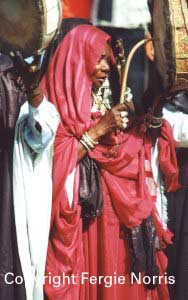
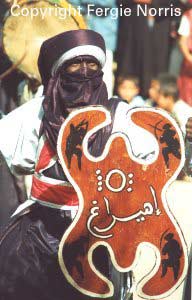
Between them and me, the men danced —whirling backwards and forwards in a graceful ballet. They wore long white robes over which they sported a black tabard—all held together by a criss-cross of red, white and gold from shoulders to waist. Their faces were totally covered by a black veil set off by a scarlet fez, bedecked with silver jewellery and turquoise tassels. They carried swords in one hand and their loved one’s scarf in the other. Others carried long, green camel whips adorned with red, orange and gold tassels. Yet another group chose beautifully decorated shields in red or ochre, depicting warriors from pre-historic times. They all danced in front of us—we could almost reach out and touch them – mesmerising us with the colour and the music—before they vanished back into the parade.
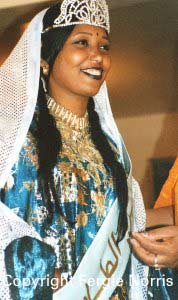
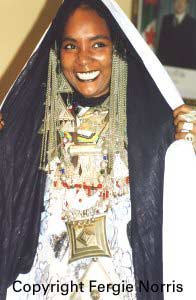
The girls had shyly ventured down a catwalk, parading a staggering array of silver jewellery appearing to adorn every square inch of their costumes. As much as 10 kilograms of silver weighed down each contestant! Tiers of silver baubles hung from head to waist. Breastplates of silver and solid silver bars hung round the neck and long hoops of silver jewellery garlanded the waist, sometimes reaching almost to the knees. Contestants wore bracelets of solid silver—as many as eight on each arm and every available finger displayed an intricately engraved silver ring.
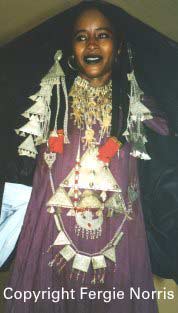
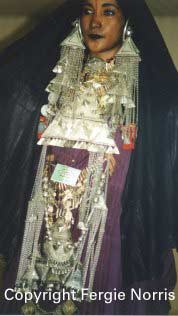
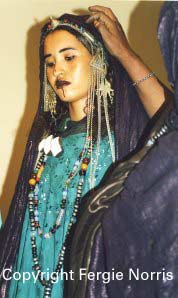
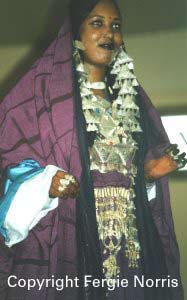
The festival was a resounding success—thanks to the vision of the Wali to develop the forty-sixth anniversary celebrations into a three-day showcase for Illizi—and to companies like BP, who had sponsored events for the enjoyment of all. I sincerely hope that this festival will become a regular event, reminding all visitors privileged to witness it of the unique and vibrant traditions of the Sahara.
